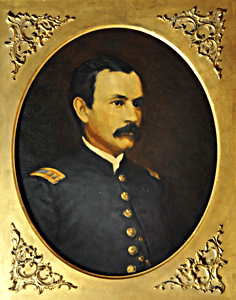| Join | Official Historian, City of Stamford | Blog | About Us | |
| Jewish Historical Society | Civil War Roundtable | Contact Us | |
|
|
|
|
The Stamford Historical Society PresentsBest Face Forward
|
 |
Oil on canvas Artist unkown 2001.4 Museum Purchase |
Marcus Waterbury enlisted on April 25, 1861 as a sergeant and was mustered into Co. F, third Conn. Vol. Infantry. He was mustered out on August 12, 1861 at Hartford.
On July 21, 1862 he was commissioned as 2nd Lieut., Co. B, 17th Conn. Vol. Infantry and was quickly promoted to 1st Lieut. On May 2, 1863 at the Battle of Chancellorsville, Virginia, he was captured and sent to Libby Prison in Richmond where he remained for a month before being released by exchange, rejoining his regiment in time to engage in the Battle of Gettysburg, July 1–4, 1863.
In September he was promoted to Captain and transferred to Co. I where he was put in charge of the recruiting camp at New Haven. One of his main duties was to safely convey recruits to the centers of action in Virginia, Hilton Head, Charleston and New Orleans. This was a risky assignment. The draft instituted in 1863 allowed individulals to pay a bounty for someone else to take their place. This fee could be as much as $300. Many of the bounty seekers were men who enlisted for the sole purpose of collecting the bounty and escaping while en route to battle areas. Known as “bounty jumpers,” they would then travel to another recruiting area and repeat the performance. If caught, the penalty could be harsh. Captain Waterbury was a vigilant man and had a very successful record – losing only one recruit out of the hundreds he and his trusty guard delivered to the battle area.
After the war, Waterbury returned to Stamford and to his position as partner in J. L. Lockwood & Co., a large tin, sheet iron, stove and house furnishing business, the same firm he had come to as a young boy from Darien to learn the tinsmith trade.
Stamford's Civil War: At Home and in the Field
Image © Stamford Historical Society